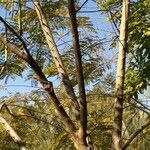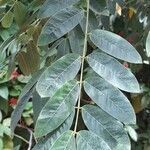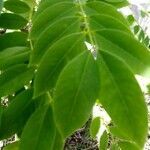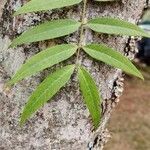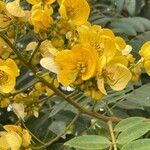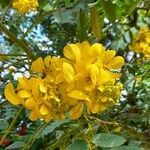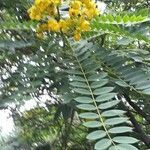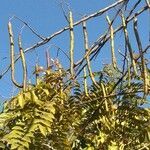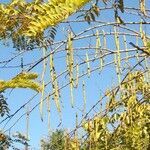Tree to 15 m tall with a spherical crown. Branchlets, young stems, and leaves pilose with golden or silver hairs, glabrate with age. Leaves 25-40 cm long, petiole 3-5 cm long, lacking a nectary; leaflets 10-15 pairs, lanceolate-elliptic, ± increasing in size distally on the rachis, the largest 3-6 cm long x 1.5-2.5 cm wide, petiole 1-3 mm long, apex acute to acuminate, rarely obtuse, base acute, venation pinnate, abaxially raised. Inflorescences of corymbiform racemes, either in the leaf axils or grouped to form terminal panicles 15-30 cm tall; sepals orbicular, subequal, glabrous or abaxially pubescent; petals irregular, obovate, 1-2.5 cm long, the largest petal with raised abaxial venation; fertile stamens 7, equal in size and shape, anthers with refuse, recurved beaks dehiscent by terminal pores; ovary displaced to one side of the flower, style short, stigma porate. Fruits pendulous, many-seeded, terete or 4-angled, linear, 20-30 cm long x 1-2 cm wide, dehiscent along 1 suture; valves dark brown, glossy, wrinkled, the papery outer layer flaking off to expose a corrugated woody inner layer that forms the walls between the seeds; seeds ovate, flattened, brown, bearing an ovate, crackled areole on each face.
Trees, evergreen, small, 5-7(-10) m tall, with long, spreading branches. Young branches, petioles, and rachises of leaves densely yellowish brown velutinous. Leaves 12-30 cm; rachis and petiole without glands; leaflets 8-15(-19) pairs, elliptic or oblong-lanceolate, 3-7 × 1-2 cm (lowermost pair usually much smaller and early caducous), abaxially densely yellowish brown velutinous, adaxially glabrous or puberulent, base subrounded and slightly oblique, apex acute, cuspidate. Flowers in terminal panicles or axillary racemes; peduncles and pedicels densely yellowish brown velutinous; bracts caducous, ovate, 4-5 mm. Sepals 5, orange-yellow, unequal: 2 outer smaller, ovate, 5-7 mm, pubescent; 3 inner larger, suborbicular, 8-11 mm in diam. Petals yellow, darkly brownish yellow veined, unequal in size, broadly to narrowly obovate, shortly clawed. Stamens 10, 7 of them fertile, anthers opening by apical pores, staminodes 3, smaller. Ovary linear, ca. 3 cm, recurved; style and stigma inconspicuous. Legume pendulous, black, narrowly cylindric, slightly compressed, 25-35 × 1-1.5 cm, slightly contracted between seeds, annulate-septate, glabrous. Seeds 50-70, suborbicular, ca. 5 mm in diam.
Small tree up to 7(-10) m tall with long, spreading leafy branches; young parts softly pubescent. Stipules linear falcate, early caducous, c. 1 cm long. Leaves with 10 — 15( — 19) pairs of leaflets; petiole 3-4 cm; rachis 20-10(-35) cm. Leaflets with short petiolule, narrowly elliptic, 3-7 by 1-2 cm (the lowermost pair usually much smaller and early caducous); base rounded, apex acute, mucronate; upper surface glabrous, lower finally appressed pubescent. Inflorescence large terminal, leafy panicles, 20-30(-90) cm; bracts ovate, 4-5 mm long, caducous; pedicels 2-3 mm, velutinous. Sepals orange-yellow, unequal, ovate to suborbicular; 2 outer pubescent, 3 inner glabrous, larger, 5-7 mm long. Petals yellow, spathulate, unequal, broadly to narrowly obovate, 2-3.5 cm with a distinct, short claw. Stamens: 1 large functioning ones with filaments 2-3 cm long, anthers opening by apical pores and a slit; staminodes 3. Ovary glabrous, recurved; style and stigma inconspicuous. Pods pendulous, more or less terete or slightly compressed, glabrous, glossy, black, annulate-septate, 18-25 by c. 1 cm. Seeds 50-70, suborbicular, c. 5 mm diam.; septae papery.
Leaves paripinnate; stipules 7–9 [4–10] mm long, linear, caducous; petiole 3.5–4 [1–3.5] cm long, pubescent, eglandular;>i> rachis 13–28 [12–36] cm long, pubescent, eglandular;>i> leaflets in 10–12 pairs, [(8)11–19(20)]>i> 5.5–8 × 1.8–2.5 [3–9.5 × 1.1–2.7] cm, the lowest pairs somewhat smaller, ovate,>i> acute, base symmetrical, cuneate, appressed-hairy beneath, sparsely appressed-puberulous above.
Petals dimorphic, golden-yellow, dark-veined when dry; four 17–19 × 14–16 mm, broadly obovate; one obovate, turned at right angles above the claw, larger than the rest.>i> Stamens 10; seven fertile with anthers c.5 mm long, and three apparently sterile with reduced flattened bilobed anthers.>i> Ovary 12–15 mm long, glabrous; style glabrous.
A shrub or small tree. It grows 7 m high. The leaves have 6-15 pairs of leaflets. These are 3-7 cm long by 1-2 m wide. They are oval with pointed tip. They have fine hairs underneath. The flowers are yellow. They are in large unbranched clusters at the ends of twigs. The fruit are pods 18-25 cn long by 1 cm wide. They are black and glossy.
Sepals 5, dimorphic, the outer two 5–6 × 4 mm, broadly ovate-elliptic, the inner three larger, 8–9 mm in diameter, suborbicular, almost glabrous.
Pod black, 16–30 × 0.9–1.2 cm, terete or subquadrate, straight, glabrous, pendulous, very tardily dehiscent along one suture, many-seeded.
(Measurements and figures in square brackets are those for South America, from Irwin & Barneby 1982)
Seeds brown, 5–7 × 3.5–5 mm, broadly obovate in outline, with elliptic areoles on each broad face.
Branchlets smooth, dark brown, puberulous to tomentellous, glabrescent.
Inflorescences large terminal panicles.
Tree to 10 m or more.
